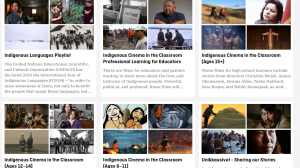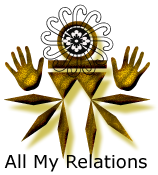The Legacy of Hope website relates back to my final question of how technology can be a tool to inspire social action in my students. The 94 calls to action are a great resource for teachers but the language is overwhelming for students. What I appreciate most about the Legacy of Hope’s Get Involved page is that it provides small steps in simple language that grade 4/5 students can understand and act on. When inspiring social action at this age, there can be a push pull with the parents. These steps range from small to large and tie nicely into other areas of curriculum to further buttress against any parent complaint (which unfortunately does exist at times).
Tag Archives: education
Module 2 – Post 3 Personal Reading Recommendation
Pulling Together: A Guide for Teachers and Instructors
This professional learning series has four sections beginning with locating yourself within history and indigenous practice through to building an indigenized practice. It offers the reader opportunities to pause, reflect, and reread before placing the information within an educational context. I found Chapter 6, Knowing yourself in relation to Indigenous People particularly interesting as a teacher. Chapter 7, Holding Space for Humility and Other Ways of Knowing and Being, had some great starting questions for considering, especially as I move to decolonize my technology use.
Module 2- Post 2: Elders in Schools
A culture centred on “All My Relations” is the foundation of all First Nations teaching and learning. The inclusion of Elders in the process can be described as the ‘heart’ of First Nations Pedagogy. Since Pre-Colonial times, Elders have been the Gatekeepers of First Nations wisdom, knowledge, and history. Elders traditionally hold crucial roles in supporting both formal and informal education in First Nations communities. They impart tradition, knowledge, culture, values, and lessons using orality and role modeling traditional practices.They are important knowledge keepers, and they also help to ensure cultural continuity.
In 2013, The Elders in Schools Program provides an opportunity for Elders to be teachers within the school setting. The program was developed to ensure every school has an elder. The main purpose is for students and staff to learn from the elders about the the wisdom, knowledge and experiences, as well as their language and traditional skills of the local people in the aboriginal communities in NWT.
https://www.ece.gov.nt.ca/en/services/renouveau-en-education-aux-tno/elders-schools-program
A similar pilot project was developedled by the Tlicho Community Services Agency in 2019.
https://www.cbc.ca/news/canada/north/pilot-program-tlicho-language-program-1.5082117
Module 2 Post #5 Rooted in Honour and Deep Respect
Carolyn Roberts spoke on March 20, 2018. She was a result of the 60’s scoop. Her mother still does not hug. She went to St. Mary’s residential school. Carolyn Roberts’s children are the first in more than three generations that were not taken away from her. Aboriginal people make up 4% of the population but more than 60% of the children in foster care are of First Nations descent.
She asks an important question – Why does it matter? She goes on to say that we need to have this conversation and we need to educate ourselves. To educate yourself you need a sense of decency and a sense of justice.
What can you do?
- You as a Canadian can learn whose land you are on. You can learn the languages that the First Nations people speak where you work, live and play. Where is the community and how can you give back to them?
- Governmental systems in place today still hold back and suppress Indigenous people. Find out about the land claims and treaty rights and what does it mean to them? Ask questions and be curious – why does the Federal Government have two white non-indigenous females leading all departments in First Nations issues.
- The honourable Murray Sinclair states that education got us into this mess, and education is what will take us out of this mess.
We need to move together side by side and our decisions need to be rooted in honour and deep respect.
M1P5: Indigenous Education Resources

This website houses some amazing information for Indigenous Education.
A school is also highlighted on this website:
“Nala’atsi is a school based in Courtenay, British Columbia for students with Indigenous ancestry in grades 10 to 12. It is a 10 month program that provides individualized support for students whose needs have not been met in a mainstream classroom setting. Nala’atsi aims to give students a sense of community and belonging, a safe and compassionate learning environment, as well as access to a variety of exciting cultural activities within the community and beyond.”
M1P4: Indigenous Cinema in the Classroom

“Our educational playlists are selections of films on themes that tie in with Canadian curricula and address the important issues of the day. Many of the playlists are also linked to our study guides.”
Within the “Indigenous Voices and Reconciliation” tab, some playlists that I have flagged for review are:
- Indigenous Cinema in the Classroom Professional Learning for Educators
- Indigenous Cinema in the Classroom (Ages 15+)
- Indigenous Cinema in the Classroom (Ages 12-14)
- Indigenous Cinema in the Classroom (Ages 6-11)
https://www.nfb.ca/education/educational-playlists/#indigenous-voices-and-reconciliation
M1P3: Indigenous Culture-Based School Mathematics in Action
Indigenous Culture-Based School Mathematics in Action: Part I: Professional Development for Creating Teaching Materials
- This first of a pair of articles describes a professional development project that prepared
four non-Indigenous mathematics teachers (Grades 5-12) to implement Canada’s Truth and
Reconciliation Commission’s (TRC, 2016) notion of reconciliation: cross-cultural respect through
mutual understanding
https://scholarworks.umt.edu/tme/vol18/iss1/9/
Meyer, Sharon and Aikenhead, Glen (2021) “Indigenous Culture-Based School Mathematics in Action: Part I: Professional Development for Creating Teaching Materials,” The Mathematics Enthusiast: Vol. 18 : No. 1 , Article 9.
__________
Indigenous Culture-Based School Mathematics in Action Part II: The Study’s Results: What Support Do Teachers Need?
- The research question: What precise supports must be in place for Grades 5 to 12 teachers to enhance their mathematics classes in a sustainable way with Indigenous mathematizing and Indigenous worldview
perspectives?
https://scholarworks.umt.edu/tme/vol18/iss1/10
Meyer, Sharon and Aikenhead, Glen (2021) “Indigenous Culture-Based School Mathematics in Action Part II: The Study’s Results: What Support Do Teachers Need?,” The Mathematics Enthusiast: Vol. 18 : No. 1 , Article 10.
_______
*June 20 – Edit*
I came across this resource that pulls together the above two pieces of research. It is from the McDowell Foundation, which provides grants for teacher-led research projects in Saskatchewan.
Culture-Based School Mathematics for Reconciliation and Professional Development
M1P2: British Columbia’s FPPL
First People’s Principles of Learning
- Looking forward to referencing this document and incorporating these principles into my classroom, and seeing how they can align with Alberta curriculum.
- I also found this link as an “informational URL” on the BC Government’s website, offering suggestions for how teachers can include the FPPL in their classrooms.

Module 1 Post 5: First People’s Principles of Learning
First Nations Education Steering Committee (FNESC) is a Vancouver-based organization dedicated to creating resources and supporting First Nations learners in British Columbia. Their resource, First People’s Principles of Learning, has been a hallmark of B.C.’s curriculum for the past couple years. FNESC suggests the FPPL acts as a “respectful and holistic approach to teaching and learning”. Learning, in this case, can refer to learning inside or outside the classroom. The principles listed prompt us as human beings to engage with oneself in a constant and consistent cycle of exploration and reflection. Learning (and therefore living) is intimately tied to ones well-being and connectedness. The FPPL is worth exploring no matter where one might be in life.
Module 1 Post 4: Life Long Learning Models
First Nations Pedagogy offers a bounty of Indigenous resources consolidated by a Canadian scholar, June Kaminski. Specifically note-worthy, the life long learning models seen through this link (half-way down the page) offers infographic representations of the ways First Nations, Inuit, and Métis communities engage with learning. Interconnectedness is a theme that runs deep across Indigenous communities, and has fortunately been more prominent in the redesign of B.C.’s curriculum. The infographics show how different domains of knowledge exist in our lives, how knowledge is gained and given, and how we fit into the puzzle at large. These models support our journeys as humans navigating our complex and intersecting lives.

